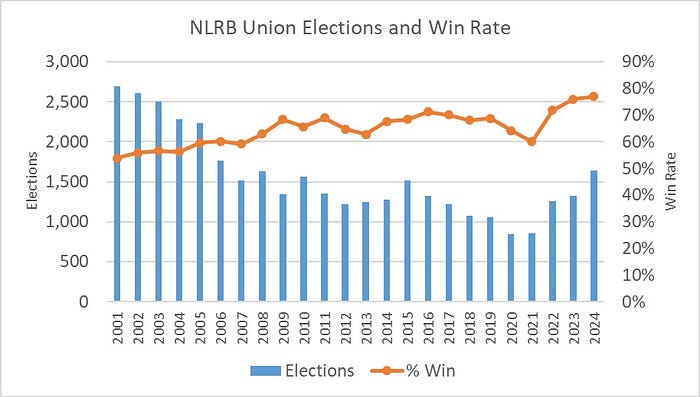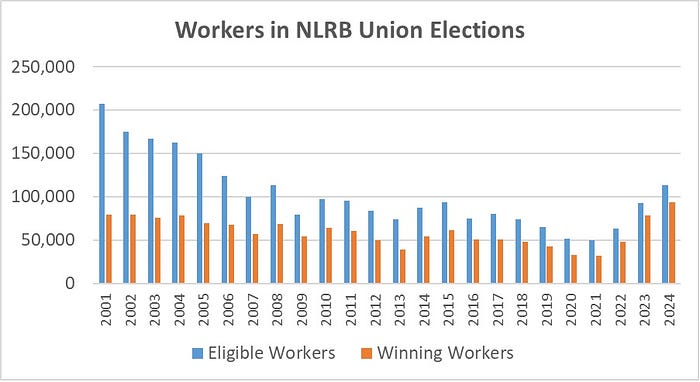U.S. Union Election Wins Surge in Fiscal Year 2024
Just released National Labor Relations Board data shows a large increase in U.S. union elections and wins, as a three year labor movement surge continues.
What’s Happening with Union Elections?
The National Labor Relations Board (NLRB) just announced that in the 2024 federal fiscal year (from October, 2023 to September, 2024) it received 3,286 union election petitions, up 27% since last year and more than double the petitions received in 2021.
That’s great news, but even more interesting is the outcome of these elections. The NLRB also released its 2024 Election Report. This report covers most private sector union elections in the U.S. Other private sector elections in the transportation sector are covered by another agency, and public sector elections are reported by various state and federal agencies.
This report has been highly anticipated (at least by me), since the NLRB had previously announced that there has been a large increase in union election petitions this last year. Moreover, this is the first full fiscal year that the NLRB’s new Cemex framework has been in effect. My summary from last year’s 2023 NLRB Election Report is here.
Because of Cemex, we need to examine not only the usual union-filed “RC” elections, but management-filed “RM” elections as well. Why? Both of these are “representation” elections that determine if the workers have majority support to join and be represented by a union. RC petitions are filed by workers and their union at a workplace when they want an election to get union certification so they can bargain a contract. RM petitions are filed by management to test whether there is majority worker support for a union (and they hope and believe there is not).
But under Cemex, the NLRB changed the rules in an important way. If a majority of workers demand voluntary union recognition from their employer, the employer can no longer just ignore this and force the workers to file an RC petition for an election. Now under Cemex the employer has two weeks to either grant union recognition, or file an RM petition to force the workers to have an election. In most cases they will file an RM petition. In the past, RM petitions have been fairly rare, but now they will become much more common. In fact, the NLRB reported earlier this year that there had been hundreds of RM petitions so far in 2024. One unfortunate weakness in this system is that any voluntary recognitions are not included in the NLRB’s annual summary, so it’s unclear how many there are.
So let’s look at the data. The chart below shows the number of closed union elections (where there has been a final result), and the union win rate going back to 2001. These are the years where the NLRB has annual Election Reports available. One can get data for previous years from the NLRB Annual Reports. This data includes both RC and RM elections added together. See the Methodology section at the end for a discussion about this data.

We can see a long term decline in the number of elections, which has been a huge problem in the labor movement, and I’ll discuss that more later. We had over 2,500 annual elections in the early 2000s, and it dropped to under 1,000 during the pandemic years of 2020 and 2021. However, the last three years have seen a promising increase in elections each year to 1,637 in 2024, a 24% increase over 2023.
Regarding RM petitions, of the total number of 2024 elections, 1,494 were RC and 143 were RM, or about 9% of the total. In contrast, over the last decade only 1.3% of all representation elections were from RM petitions. In terms of particular win rates, the 2024 RC elections had 78.1% and RM elections had 65.5%. This is a much higher RM win rate than over the last decade, which was 29%, reflecting the conditions of much stronger union strength that generate RM petitions now.
The long term trend of the win rate is particularly interesting. Over the last few decades, it has improved quite a bit, from less than 55% to well over 70%. The last three years in particular have been stunning, with win rates of 72%, 76% and 77%. My interpretation of both these trends is that unions have concentrated their resources on fewer elections, but have gotten better over time at winning them.
The chart below shows the number of workers eligible to vote in these elections and the number of workers in the winning elections. Again this is for both RC and RM elections together.

As before, we see a long term decline in the number of workers voting in these elections, but with an increase in the last three years, topping 100,000 for the first time since 2008. Similarly, the number of workers who won their elections also declined to a very low of about 32,000 workers in both 2020 and 2021, but has risen again recently to almost 94,000. In fact, the higher number of elections and great win rate in 2024 resulted in a number of workers who won their elections that is larger than all the years going back to 2001.
Better But Not Enough
Why have we seen such an improved union election performance in the last three years? I think it’s a combination of worker discontent arising out of the COVID-19 pandemic labor conditions, greater union interest among younger Gen Z workers, and a more aggressive NLRB under the Biden administration that has contributed to this recent surge.
But we need to do much more. Union membership rates have been falling for decades, and the U.S. Bureau of Labor Statistics (BLS) reported that last year it stood at about 10% of the workforce, and an appallingly low 6% in the private sector. The number of “represented” workers, which also includes workers who are not union members but are covered under union contracts, is slightly higher.
The last BLS report states that there are about 145 million workers in the U.S. workforce. So to grow the union membership rate by even 1% means adding 1.45 million new members to unions. This includes newly organized workers and also net new union jobs added by employers (union workers that were hired vs. fired that year).
But the majority of this will have to come from newly organizing workers, and that means a lot more elections. In 2024 there were almost 100,000 workers that won their NLRB elections. There are of course other workers who organized outside of these elections, so the total number of newly organized workers is larger, but not that much larger.
So for the labor movement to start to grow again, we need at least 5 times that number, and ideally 10 times, every year. If that sounds like a lot, it is. If it sounds like too much, it better not be because that’s what’s necessary. A recent analysis shows that the amount of current organizing compared to the size of the workforce is 1/10 the level we had in the 1970s. That decade had several years with over 8,000 elections.
The interest among workers for accelerated organizing is certainly there. The latest Gallup poll found that 70% of Americans approve of unions. We just need the labor movement to scale up its organizing to meet this great need. How can we do this? Well an analysis of labor movement finances has found that unions have the funds to hire tens of thousands of new organizers. That needs to happen now.
We also need newer strategies such as training lots of new workers to do their own organizing. I’ve been involved for several years with the Emergency Workplace Organizing Committee (EWOC), which has a network of volunteers that have trained thousands of workers to run their own organizing campaigns. That needs to scale up. EWOC also has a report that I contributed to about an organizing strategy called Pre-Majority Unionism, where workers organize for improvements at work without necessarily running elections and getting a contract. That strategy has its own challenges, but it’s available to any group of workers to get started on organizing now. For some, like public sector workers in states without collective bargaining rights, that’s the strategy they will have to use, until they build enough power to win the right to a contract.
It also has to be said that any strategy for labor movement growth that depends primarily on running a lot more NLRB elections needs a much better funded and staffed NLRB. The NLRB recently stated,
In the past two decades, staffing in field offices has shrunk by 50%. In FY 2011, when the NLRB faced a similar volume of case intake, the Agency had 62% more field staff — 1,222 in FY 2011 vs. 754 in FY 2024 — allowing the investigation and resolution of cases much more quickly.
That’s a huge political battle as the Republicans want to destroy the labor movement, and the Democrats won’t prioritize helping it, even though it would benefit them politically. There is also the issue of passing meaningful labor law reform, such as the PRO Act, which has failed for decades and seems unlikely in the near future. The labor movement may just not be powerful enough to get better labor law until it grows more.
Union membership is not only relatively small compared to the whole workforce, it is concentrated in too few states. Almost half of all union members are in just six states, and 11 states have union membership rates less than 5%. That means elected officials in too many states can vote against pro-union legislation with little consequences. I don’t think any viable strategy for union growth can depend on significant labor law reform, but we should certainly push hard for more NLRB funding.
So What Now?
If we’re in a modern labor upsurge, we have to keep going. Whatever happens with the next election this November, the labor movement has to step up its organizing with more funding, creative strategies, and an all-in effort. The call by the UAW for unions to align their contracts for a possible General Strike in 2028 is the kind of bold move we need.
President Biden implemented a lot of pro-worker and pro-union policies. A President Harris will largely continue these policies, and we can hopefully accelerate this recent organizing momentum. With a President Trump again, armed with the Heritage Foundation’s Project 2025 assault on workers and unions, organizing will get harder, but of course will still be essential.
P.S. Fun fact, if we meet anyone who thinks Trump has nothing to do with Project 2025, show them this 2018 Heritage press release about how Trump embraced 64% of their last compilation of dumb ideas.

Methodology
I gathered data on union elections from the NLRB Election Reports from 2001–2024. The NLRB tends to change over time how they present data. For 2001–2010, I used the numbers from the September report (last month of the fiscal year) in the first chart, “FISCAL YEAR 20XX SUMMARY OF ELECTIONS.” I took the total elections, union wins, total employees, and employees won by unions. This data covers both RC and RM elections together. For 2011–2024, I used the stated number of RC and RM Elections, Percent Won by Union, and the Total Employees Eligible. I calculated the number of won elections. I counted the number of workers who won their elections by sorting all the elections in a spreadsheet, for both RC and RM elections. Note that this number is different than the reported number of Total Valid Votes For, which reports the yes votes in all the elections.
